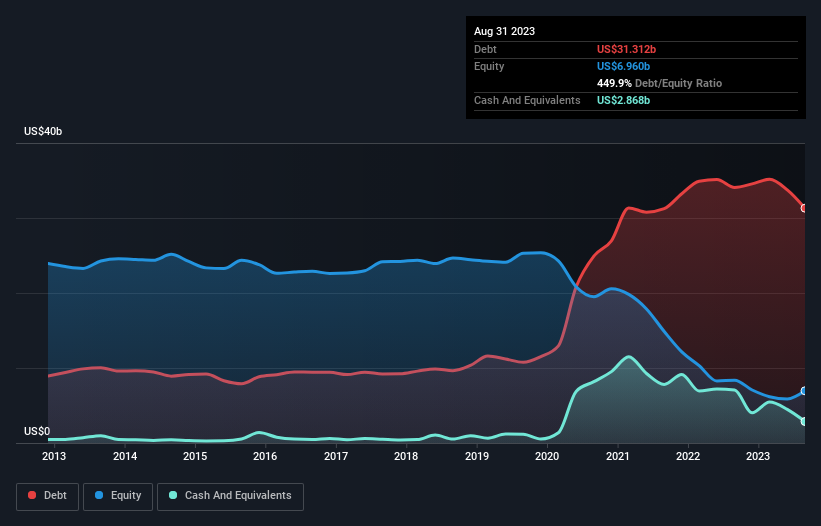- United States
- /
- Hospitality
- /
- NYSE:CCL
Carnival Corporation & (NYSE:CCL) Use Of Debt Could Be Considered Risky

Some say volatility, rather than debt, is the best way to think about risk as an investor, but Warren Buffett famously said that 'Volatility is far from synonymous with risk.' So it seems the smart money knows that debt - which is usually involved in bankruptcies - is a very important factor, when you assess how risky a company is. As with many other companies Carnival Corporation & plc (NYSE:CCL) makes use of debt. But is this debt a concern to shareholders?
Why Does Debt Bring Risk?
Debt and other liabilities become risky for a business when it cannot easily fulfill those obligations, either with free cash flow or by raising capital at an attractive price. Ultimately, if the company can't fulfill its legal obligations to repay debt, shareholders could walk away with nothing. While that is not too common, we often do see indebted companies permanently diluting shareholders because lenders force them to raise capital at a distressed price. Of course, plenty of companies use debt to fund growth, without any negative consequences. The first step when considering a company's debt levels is to consider its cash and debt together.
View our latest analysis for Carnival Corporation &
What Is Carnival Corporation &'s Net Debt?
You can click the graphic below for the historical numbers, but it shows that Carnival Corporation & had US$31.3b of debt in August 2023, down from US$34.1b, one year before. However, it does have US$2.87b in cash offsetting this, leading to net debt of about US$28.4b.

How Strong Is Carnival Corporation &'s Balance Sheet?
The latest balance sheet data shows that Carnival Corporation & had liabilities of US$11.0b due within a year, and liabilities of US$31.8b falling due after that. On the other hand, it had cash of US$2.87b and US$757.0m worth of receivables due within a year. So its liabilities outweigh the sum of its cash and (near-term) receivables by US$39.2b.
This deficit casts a shadow over the US$18.0b company, like a colossus towering over mere mortals. So we'd watch its balance sheet closely, without a doubt. After all, Carnival Corporation & would likely require a major re-capitalisation if it had to pay its creditors today.
In order to size up a company's debt relative to its earnings, we calculate its net debt divided by its earnings before interest, tax, depreciation, and amortization (EBITDA) and its earnings before interest and tax (EBIT) divided by its interest expense (its interest cover). Thus we consider debt relative to earnings both with and without depreciation and amortization expenses.
Weak interest cover of 0.47 times and a disturbingly high net debt to EBITDA ratio of 8.9 hit our confidence in Carnival Corporation & like a one-two punch to the gut. The debt burden here is substantial. One redeeming factor for Carnival Corporation & is that it turned last year's EBIT loss into a gain of US$861m, over the last twelve months. The balance sheet is clearly the area to focus on when you are analysing debt. But ultimately the future profitability of the business will decide if Carnival Corporation & can strengthen its balance sheet over time. So if you want to see what the professionals think, you might find this free report on analyst profit forecasts to be interesting.
Finally, while the tax-man may adore accounting profits, lenders only accept cold hard cash. So it is important to check how much of its earnings before interest and tax (EBIT) converts to actual free cash flow. Over the last year, Carnival Corporation & saw substantial negative free cash flow, in total. While that may be a result of expenditure for growth, it does make the debt far more risky.
Our View
To be frank both Carnival Corporation &'s conversion of EBIT to free cash flow and its track record of staying on top of its total liabilities make us rather uncomfortable with its debt levels. But at least its EBIT growth rate is not so bad. We think the chances that Carnival Corporation & has too much debt a very significant. To our minds, that means the stock is rather high risk, and probably one to avoid; but to each their own (investing) style. Given the risks around Carnival Corporation &'s use of debt, the sensible thing to do is to check if insiders have been unloading the stock.
When all is said and done, sometimes its easier to focus on companies that don't even need debt. Readers can access a list of growth stocks with zero net debt 100% free, right now.
New: AI Stock Screener & Alerts
Our new AI Stock Screener scans the market every day to uncover opportunities.
• Dividend Powerhouses (3%+ Yield)
• Undervalued Small Caps with Insider Buying
• High growth Tech and AI Companies
Or build your own from over 50 metrics.
Have feedback on this article? Concerned about the content? Get in touch with us directly. Alternatively, email editorial-team (at) simplywallst.com.
This article by Simply Wall St is general in nature. We provide commentary based on historical data and analyst forecasts only using an unbiased methodology and our articles are not intended to be financial advice. It does not constitute a recommendation to buy or sell any stock, and does not take account of your objectives, or your financial situation. We aim to bring you long-term focused analysis driven by fundamental data. Note that our analysis may not factor in the latest price-sensitive company announcements or qualitative material. Simply Wall St has no position in any stocks mentioned.
About NYSE:CCL
Carnival Corporation &
A cruise company, provides leisure travel services in North America, Australia, Europe, and internationally.
Undervalued with solid track record.
Similar Companies
Market Insights
Community Narratives





